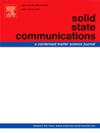Mn掺杂对自旋电子材料ZnMnxSn1-xAs2磁热电性能的影响
IF 2.4
4区 物理与天体物理
Q3 PHYSICS, CONDENSED MATTER
引用次数: 0
摘要
本文利用全势线性化增广平面波(FP-LAPW)方法和trans - blaha修正的Becke-Johnson泛函(TB-mBJ)对mn掺杂ZnSnAs2黄黄矿进行了全面的自旋极化密度泛函(DFT)分析。研究了掺杂ZnMnxSn(1−x)As2在掺杂0≤x≤0.5范围内的电子、磁性和热电性能。Mn掺杂在Sn位点产生显著的自旋磁矩,导致半金属和高自旋铁磁态。随着Mn浓度的增加,大多数自旋态保持带隙,而少数自旋态表现为简并半导体。这导致磁矩的整体增加,使材料有望用于自旋电子应用。本研究还利用玻尔兹曼输运理论探讨了恒定散射时间近似下的热电性质。主要的热电参数包括Seebeck系数(S)、电导率(σ)和电子导热系数(κ)作为温度和掺杂浓度的函数。Mn掺杂提高了热电性能,在500 K时得到了最高的ZT,接近1.2。自旋依赖的贡献起着至关重要的作用,与多数自旋态相比,少数自旋态表现出更高的比热(Cv)和功率因数(PF)值。这些发现表明,Mn掺杂不仅促进了Mn掺杂ZnSnAs2的自旋电子应用,而且提高了材料的热电效率,可以用于能量转换应用。本文章由计算机程序翻译,如有差异,请以英文原文为准。
Influence of Mn doping on magneto-thermoelectric properties of spintronic material ZnMnxSn1-xAs2
In present investigation a comprehensive spin-polarized density functional theory (DFT) analysis of Mn-doped ZnSnAs2 chalcopyrite carried out by utilizing the Full-Potential Linearized Augmented Plane Wave (FP-LAPW) method with Tran-Blaha’s modified Becke-Johnson (TB-mBJ) functional. Electronic, magnetic, and thermoelectric properties of doped ZnMnSnAs investigated within the doping range . Mn doping at Sn site induces a significant spin magnetic moment, leading to a half-metallic and high-spin ferromagnetic state. With increasing Mn concentration, the majority spin state retains bandgap while the minority spin state behaves like a degenerate semiconductor. This results an overall increase in magnetic moment and making the material promising for spintronic applications. This study also explores thermoelectric properties using Boltzmann transport theory within the constant scattering time approximation. The key thermoelectric parameters, including the Seebeck coefficient (S), electrical conductivity (), and electronic thermal conductivity () were evaluated as functions of temperature and doping concentrations. Mn doping enhances the thermoelectric performance and we get highest Figure of merit (ZT) nearly 1.2 at 500 K for higher Mn concentrations. Spin-dependent contributions play a crucial role, minority-spin state exhibiting higher specific heat () and power factor (PF) values as compared with majority-spin states. These findings suggest that Mn doping not only boosts the spintronic application of Mn doped ZnSnAs2 but also enhances thermoelectric efficiency of the materials and may be utilized for energy conversion applications.
求助全文
通过发布文献求助,成功后即可免费获取论文全文。
去求助
来源期刊

Solid State Communications
物理-物理:凝聚态物理
CiteScore
3.40
自引率
4.80%
发文量
287
审稿时长
51 days
期刊介绍:
Solid State Communications is an international medium for the publication of short communications and original research articles on significant developments in condensed matter science, giving scientists immediate access to important, recently completed work. The journal publishes original experimental and theoretical research on the physical and chemical properties of solids and other condensed systems and also on their preparation. The submission of manuscripts reporting research on the basic physics of materials science and devices, as well as of state-of-the-art microstructures and nanostructures, is encouraged.
A coherent quantitative treatment emphasizing new physics is expected rather than a simple accumulation of experimental data. Consistent with these aims, the short communications should be kept concise and short, usually not longer than six printed pages. The number of figures and tables should also be kept to a minimum. Solid State Communications now also welcomes original research articles without length restrictions.
The Fast-Track section of Solid State Communications is the venue for very rapid publication of short communications on significant developments in condensed matter science. The goal is to offer the broad condensed matter community quick and immediate access to publish recently completed papers in research areas that are rapidly evolving and in which there are developments with great potential impact.
 求助内容:
求助内容: 应助结果提醒方式:
应助结果提醒方式:


